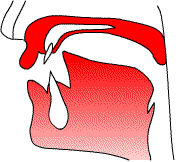Retroflexes
Retroflex sounds are made with the tongue tip curled back. Depending on how far the tongue curls back, retroflexes could be apico-postalveolar or apico-palatal. In some languages, retroflex plosives have the tongue curled back so far that the part that contacts the roof of the mouth is the underside of the tongue tip.
 We have been calling the [ɹ] of English a retroflex. Yet we've used the [ɹ] symbol from the dental-alveolar-postalveolar mega-column of the IPA chart, not the [ ɻ ] symbol from the retroflex column. Part of this is officially sanctioned laziness: [ɹ] is a simpler symbol than [ ɻ ], so we might as well use it if it's just as appropriate. And it is. The tongue-tip in the postalveolar region can just as well be described as postalveolar, so the sound has a legitimate claim on the [ɹ] symbol from the mega-column, and English has no dental or alveolar approximants that we need to avoid confusion with.
We have been calling the [ɹ] of English a retroflex. Yet we've used the [ɹ] symbol from the dental-alveolar-postalveolar mega-column of the IPA chart, not the [ ɻ ] symbol from the retroflex column. Part of this is officially sanctioned laziness: [ɹ] is a simpler symbol than [ ɻ ], so we might as well use it if it's just as appropriate. And it is. The tongue-tip in the postalveolar region can just as well be described as postalveolar, so the sound has a legitimate claim on the [ɹ] symbol from the mega-column, and English has no dental or alveolar approximants that we need to avoid confusion with.
But we're also kind of exaggerating when we call English [ɹ] a retroflex. Although the tongue tip is certainly more curled back for [ɹ] than for any other sound of English, the amount that it's curled back isn't so impressive compared with languages that have a whole set of real retroflexes.
Many of the languages of India and Australia have a whole series of retroflexes, including plosives, nasals, fricatives, and sometimes approximants.
Indian English typically uses retroflex [ ʈ ] and [ ɖ ] where other dialects of English use alveolar [t] and [d].
Mandarin Chinese:
| IPA (no tone) |
Pinyin |
meaning |
| [ʂɑŋhai̯] |
shanghai |
'Shanghai' |
| [ɖʐəŋ] |
zheng |
|
| [ʈʂao̯] |
chao |
|
| [ʈʂʐ̩ ] |
chi |
'eat' |
 We have been calling the [ɹ] of English a retroflex. Yet we've used the [ɹ] symbol from the dental-alveolar-postalveolar mega-column of the IPA chart, not the [ ɻ ] symbol from the retroflex column. Part of this is officially sanctioned laziness: [ɹ] is a simpler symbol than [ ɻ ], so we might as well use it if it's just as appropriate. And it is. The tongue-tip in the postalveolar region can just as well be described as postalveolar, so the sound has a legitimate claim on the [ɹ] symbol from the mega-column, and English has no dental or alveolar approximants that we need to avoid confusion with.
We have been calling the [ɹ] of English a retroflex. Yet we've used the [ɹ] symbol from the dental-alveolar-postalveolar mega-column of the IPA chart, not the [ ɻ ] symbol from the retroflex column. Part of this is officially sanctioned laziness: [ɹ] is a simpler symbol than [ ɻ ], so we might as well use it if it's just as appropriate. And it is. The tongue-tip in the postalveolar region can just as well be described as postalveolar, so the sound has a legitimate claim on the [ɹ] symbol from the mega-column, and English has no dental or alveolar approximants that we need to avoid confusion with. 


